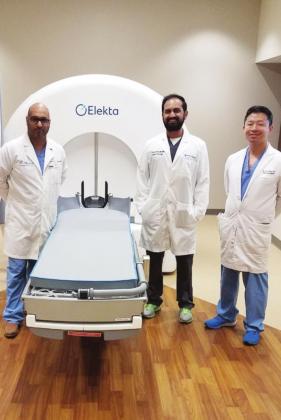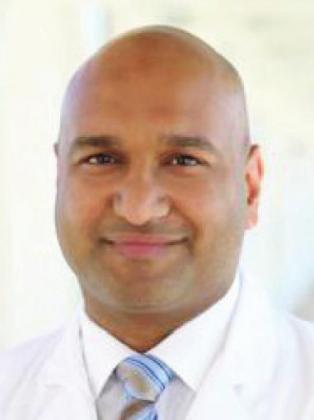THE BRAIN is the central processing unit of the human body, a highly complex, sensitive organ that controls all bodily functions, interprets the world around us, and is the source of every thought and emotion we have. It’s not surprising, then, that the diagnosis of a tumor or other abnormality in the brain typically elicits a significant degree of fear and uncertainty in patients. They worry not only about the potential effects of the tumor itself, but also about how any medical intervention to treat the lesion might affect them.
The good news for Toledo-area residents is that Mercy Health – Perrysburg Hospital now offers an advanced, highly precise form of radiation for the treatment of both benign and cancerous tumors and other abnormalities in the brain that involves no incisions, no pain, and significantly less damage to surrounding tissue and nearby structures. This non-invasive procedure, called Gamma Knife® stereotactic radiosurgery, or SRS, requires no general anesthesia and can usually be performed in one session in an outpatient setting, eliminating the need for a hospital stay. Mercy Health – Perrysburg Hospital is currently the only facility in Northwest Ohio offering this treatment modality.
According to Suketu Patel, MD, medical director for Mercy Health Radiation Oncology, the Gamma Knife produces 192 beams of very-low-dose radiation, which can be set up in different configurations and sizes. Like spokes on a wheel, the separate, low-dose beams converge at a single focal point, creating a high dose of radiation that is delivered to a very precise treatment area in the brain with very little damage or toxicity to healthy tissue. MRI and CT imaging are used in treatment planning to ensure the radiation is targeted precisely, and every treatment is individualized based on factors such as tumor size, shape, and location.
“Gamma Knife offers a wide range of benefits over conventional surgery,” Dr. Patel states. “Not only is it completely non-invasive, and therefore much safer, but it also allows us to treat areas of the brain that can’t be accessed through conventional surgery. For instance, with this technology, we can target a very small lesion located right near the brain stem. Essentially, Gamma Knife is a way to treat tumors or other abnormalities from the outside in without cutting anything to get there.”
Zubair Ahammad, MD, chairman of Neurosurgery at Mercy Health – St. Vincent Medical Center, adds, “‘Gamma Knife’ is something of a misnomer because it’s not actually a surgical procedure in the traditional sense and no knife is involved. The name was chosen to reflect the focality and surgical precision of the technology, which allows us to deliver a higher dose of radiation in a much more targeted manner than we could before.”
In addition to malignant tumors, Gamma Knife can be used to treat other lesions or pathologies in the brain, including benign tumors such as acoustic neuromas, arteriovenous malformations (AVMs) and other vascular abnormalities, pain syndromes such as trigeminal neuralgia, and even certain functional disorders such as Parkinson’s disease.
Dr. Ahammad explains that with Parkinson’s, treatment commonly involves creating tiny lesions, or micro-injuries, in specific regions of the brain to disrupt the neurological pathways associated with symptoms such as slow movement, rigidity, and tremor. Gamma Knife allows neurosurgeons to create these lesions with the highest degree of safety and precision. “For example, one reason Parkinson’s patients are referred to neurosurgery is for deep brain stimulation, or DBS, which involves implanting a thin electrode in the brain that delivers electrical stimulation to help improve symptoms and the patient’s level of function. With Gamma Knife, instead of implanting an electrode, we use a focused beam of radiation to create tiny lesions, disrupting the pathway to symptoms.”
Gamma Knife treatment is a good option for a broad range of patients, ranging from young to old. Dr. Patel comments, “The procedure is a good option for elderly people who have other comorbidities or who aren’t good candidates for surgery. Plus, because Gamma Knife spares healthy tissue, you can prevent a lot of longterm issues compared to conventional surgery, which is a great benefit for younger patients who still have a long life ahead of them.”
Regardless of age, patients appreciate the convenience and relative comfort of Gamma Knife treatment compared to conventional surgery. Dr. Patel notes that the procedure is typically done in a single day—usually beginning in the morning and finishing in the afternoon. In addition, whereas earlier versions of the treatment platform required the use of a frame that had to be affixed to the patient’s head, the latest version uses a mask to immobilize the patient’s head. “The mask simply holds the forehead and chin in position while allowing the patient to see and breathe through it. During the actual procedure, the patient doesn’t feel anything, so no anesthesia is necessary, and there’s no heat or bright lights.”
Dr. Patel and Dr. Ahammad are both proud to offer this state-of-the-art treatment to patients in Northwest Ohio. “Gamma Knife has become the gold-standard of treatment for tumors of the brain, whether cancerous or noncancerous. Now that Mercy Health is offering this modality, area residents have access to a level of care that rivals that of any other facility in the country,” Dr. Patel says.
Dr. Ahammad adds, “Gamma Knife is a game-changer because it allows us to deliver a high dose of radiation much more safely and with fewer side effects, makes more tumors amenable to radiation therapy, and puts radiation on the table as a viable treatment when surgery may have been the only option in the past.”




